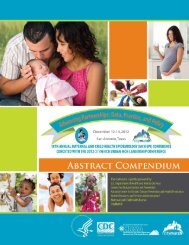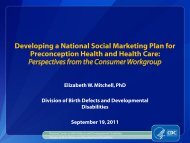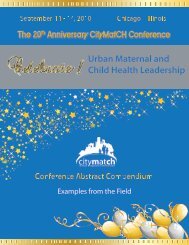Conference Abstract Compendium Examples from the ... - CityMatCH
Conference Abstract Compendium Examples from the ... - CityMatCH
Conference Abstract Compendium Examples from the ... - CityMatCH
You also want an ePaper? Increase the reach of your titles
YUMPU automatically turns print PDFs into web optimized ePapers that Google loves.
2009 <strong>CityMatCH</strong> Urban MCH Leadership <strong>Conference</strong>• Identify parent reported behaviors.• Develop evidence to guide next steps for promoting safe sleep among practices in target communities.Physicians and staff <strong>from</strong> 12 practices were surveyed (275 total) to assess knowledge/practices about safesleep education. Staff was also surveyed about readiness for change, barriers to, and what would facilitatechange in, patient education. Patients at each site were also surveyed (652 total) to obtain informationabout education <strong>the</strong>y received <strong>from</strong> <strong>the</strong> practice regarding infant care, health and safety, and <strong>the</strong>irperceptions/practices regarding infant safe sleep.ACCOMPLISHMENTS/RESULTS• Parent education about safe sleep increases <strong>the</strong> likelihood of practicing safe sleep. Conversely,education on ‘SIDS’ did not significantly predict safe sleep practice.• Women’s/parents’ knowledge of back sleep (83.3%) and crib usage (94.4%) was good but neededimprovement on o<strong>the</strong>r safe sleep measures, e.g., bedsharing, soft bedding.• There were important gaps in knowledge and inconsistent practice among pediatric providers.• There were significant differences between ob/gyn and pediatric practices: only 1/3 of ob/gyn practicesreported providing safe sleep education compared to over 3/4 of pediatric practices.BARRIERS• Inadequate staff knowledge about all facets of safe sleep practices.• Lack of perception of <strong>the</strong> need to change patient education practices.• Lack of access to materials and methods to address diverse languages, cultures, education levels, andengaging extended family.• Lack of time/office space to educate patients.LESSONS LEARNED• Physician practices may not be reaching <strong>the</strong>ir full potential in providing safe sleep education.• Practical, knowledge, and attitudinal barriers need to be addressed to enhance providers’ roles inproviding safe sleep education.• Providers could consider safe sleep education as quality assurance/quality improvement initiatives.• Health departments can partner with health plans and clinics to support data collection on safe sleep ando<strong>the</strong>r infant health issues.40







